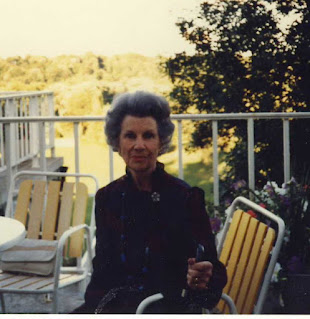Jeanne Chevalier was born November 27, 1891 in Montreal, Quebec. She was the daughter of French born banker Martial Chevalier and Charlotte Peters, a descendant of Irish immigrants. Her grandfather was the manager of the Crédit Foncier Franco-Canadien and French Consul in Quebec and the Chevalier family were devout Catholics. Her grandfather's diplomatic post meant frequent transatlantic voyages by steam ship but Jeanne, athletically disposed from a young age, found time to pursue horseback riding, skiing, golf, tennis and swimming. However, it was clear her greatest talent lied on the ice.
Skating alone or together, there was no stopping Norman and Jeanne. In 1910, Jeanne made her debut at the Canadian Championships, claiming the fours title with E.V. Hall, Iris Mudge and Allan Richardson. In 1913, Norman and Jeanne each finished second in their respective singles events as well as second in the pairs and fours competitions. Later that winter, the talented twosome attended a skating party at Rideau Skating Club where a team of 'society belles' played hockey against a team of suffragists. The event got their competitive juices flowing. At the first meeting of the Figure Skating Department of the Amateur Skating Association of Canada on September 27, 1913, Norman was appointed as one of the Association's first nine judges.
Jeanne Chevalier's skates. Photo courtesy Henri Rousseau article for "Au fil du temps".
Motivated by their losses in 1913, Norman and Jeanne returned to the Canadian Championships the following year in full force. Norman took the men's title, Jeanne placed second in the women's event and together, they claimed the pairs title. At the international competition that winter in New Haven, Connecticut that was later recognized as the first U.S. Championships, the duo won the pairs competition and Norman won the men's event. That summer, World War I broke out. Making use of his training in the Canadian Officers' Training Corps at McGill, Norman enlisted in the War effort and headed overseas to serve with the Royal Canadian Engineers, the Royal Naval Air Service and the Royal Air Force. While he was in Europe fighting the good fight, Jeanne served as a nurse at a military hospital near Montreal with the Order of Saint John of Jerusalem and pondered the fate of her three brothers and skating partner fighting on the front lines overseas.
When Norman returned to Canada in 1919, he was injured but had earned the rank of Captain. He took a job in civil engineering and quickly resumed the skating career that had been postponed for five years. In 1920, he won the Canadian fours title with Jeanne, J. Cecil McDougall and Winnifred Tait and Jeanne finally claimed the Canadian women's title that had eluded her. The following year, Norman became the first skater to pass the Amateur Skating Association of Canada's silver class test and bested Duncan McIntyre Hodgson and Melville Rogers to reclaim his Canadian men's title after an almost ten year absence from the competitive ranks. Jeanne repeated as the Canadian women's champion and won another fours title, this time with Allan Howard, Winnifred Tait and Norman Gregory.
Georges-Auguste-Elie Lavergne portrait of Jeanne Chevalier
After those 1921 Canadian Championships, both Jeanne and Norman retired from competitive skating. After serving as the Secretary and Treasurer of the Figure Skating Department of the Amateur Skating Association of Canada during the final years of his competitive career, Norman served for another ten plus years on that organization's board, working closely alongside Louis Rubenstein to help develop Canadian figure skating in the roaring twenties. He and wife Margery travelled extensively with his new line of work... investment banking with the Bank Of Montreal.
Norman's wife Margery
Jeanne's parents decided to move back to France, the country of her father's birth, and she followed suit. Not long after arriving, she began seeing a French architect and painter named Louis Esgonniere de Thibeuf. The couple married in June of 1923, moved to his castle and soon welcomed three daughters to the world. Her daughter Renée once said, "We saw her skate twice. During the winters of 1936 and 1940, on a frozen pond below the estate. We were amazed. What elegance! She held us by the hand. An unforgettable memory."
The Thibeuf castle in Bournezeau, France where Jeanne Chevalier lived and passed away
In 1932, Norman became the first Canadian to judge at an ISU championship (the World Championships in Montreal) where Canadian skaters found themselves on the podium in multiple disciplines for the very first time. So respected was Norman that his likeness appeared on the ASA and CFSA's championship medals for several decades! Sadly, Norman died in September of 1981 at the age of eighty-nine in Georgeville, Quebec. He was finally given recognition for his incredible contributions to Canadian figure skating in 2012 with an induction to Skate Canada's Hall Of Fame. Jeanne died peacefully on December 8, 1984 at the the castle of Thibeuf in the Bournezeau commune in Vendée, France at age of ninety-three.







